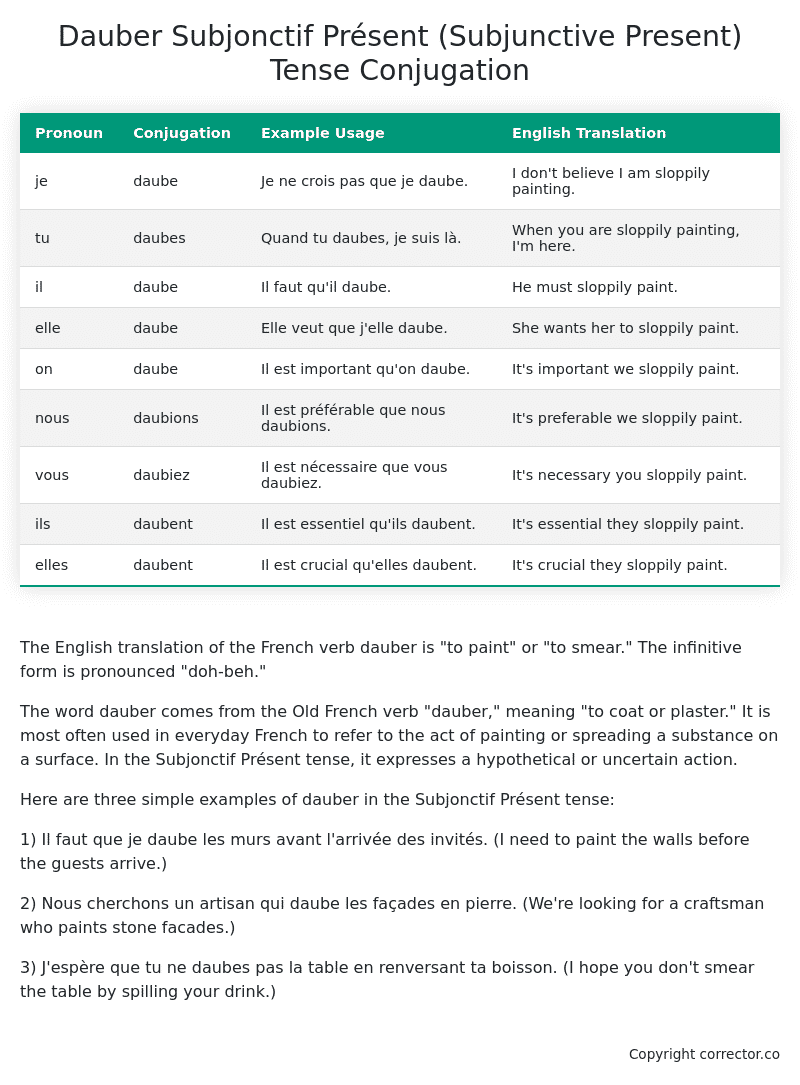Subjonctif Présent (Subjunctive Present) Tense Conjugation of the French Verb dauber
Introduction to the verb dauber
The English translation of the French verb dauber is “to paint” or “to smear.” The infinitive form is pronounced “doh-beh.”
The word dauber comes from the Old French verb “dauber,” meaning “to coat or plaster.” It is most often used in everyday French to refer to the act of painting or spreading a substance on a surface. In the Subjonctif Présent tense, it expresses a hypothetical or uncertain action.
Here are three simple examples of dauber in the Subjonctif Présent tense:
1) Il faut que je daube les murs avant l’arrivée des invités. (I need to paint the walls before the guests arrive.)
2) Nous cherchons un artisan qui daube les façades en pierre. (We’re looking for a craftsman who paints stone facades.)
3) J’espère que tu ne daubes pas la table en renversant ta boisson. (I hope you don’t smear the table by spilling your drink.)
Table of the Subjonctif Présent (Subjunctive Present) Tense Conjugation of dauber
| Pronoun | Conjugation | Example Usage | English Translation |
|---|---|---|---|
| je | daube | Je ne crois pas que je daube. | I don’t believe I am sloppily painting. |
| tu | daubes | Quand tu daubes, je suis là. | When you are sloppily painting, I’m here. |
| il | daube | Il faut qu’il daube. | He must sloppily paint. |
| elle | daube | Elle veut que j’elle daube. | She wants her to sloppily paint. |
| on | daube | Il est important qu’on daube. | It’s important we sloppily paint. |
| nous | daubions | Il est préférable que nous daubions. | It’s preferable we sloppily paint. |
| vous | daubiez | Il est nécessaire que vous daubiez. | It’s necessary you sloppily paint. |
| ils | daubent | Il est essentiel qu’ils daubent. | It’s essential they sloppily paint. |
| elles | daubent | Il est crucial qu’elles daubent. | It’s crucial they sloppily paint. |
Other Conjugations for Dauber.
Le Present (Present Tense) Conjugation of the French Verb dauber
Imparfait (Imperfect) Tense Conjugation of the French Verb dauber
Passé Simple (Simple Past) Tense Conjugation of the French Verb dauber
Passé Composé (Present Perfect) Tense Conjugation of the French Verb dauber
Futur Simple (Simple Future) Tense Conjugation of the French Verb dauber
Futur Proche (Near Future) Tense Conjugation of the French Verb dauber
Plus-que-parfait (Pluperfect) Tense Conjugation of the French Verb dauber
Passé Antérieur (Past Anterior) Tense Conjugation of the French Verb dauber
Futur Antérieur (Future Anterior) Tense Conjugation of the French Verb dauber
Subjonctif Présent (Subjunctive Present) Tense Conjugation of the French Verb dauber (this article)
Subjonctif Passé (Subjunctive Past) Tense Conjugation of the French Verb dauber
Subjonctif Imparfait (Subjunctive Imperfect) Tense Conjugation of the French Verb dauber
Subjonctif Plus-que-parfait (Subjunctive Pluperfect) Tense Conjugation of the French Verb dauber
Conditionnel Présent (Conditional Present) Tense Conjugation of the French Verb dauber
Conditionnel Passé (Conditional Past) Tense Conjugation of the French Verb dauber
L’impératif Présent (Imperative Present) Tense Conjugation of the French Verb dauber
L’infinitif Présent (Infinitive Present) Tense Conjugation of the French Verb dauber
Struggling with French verbs or the language in general? Why not use our free French Grammar Checker – no registration required!
Get a FREE Download Study Sheet of this Conjugation 🔥
Simply right click the image below, click “save image” and get your free reference for the dauber Subjonctif Présent tense conjugation!

Dauber – About the French Subjonctif Présent (Subjunctive Present) Tense
Formation of the Subjonctif Présent
Common Everyday Usage Patterns
Interactions with Other Tenses
Summary
I hope you enjoyed this article on the verb dauber. Still in a learning mood? Check out another TOTALLY random French verb conjugation!


